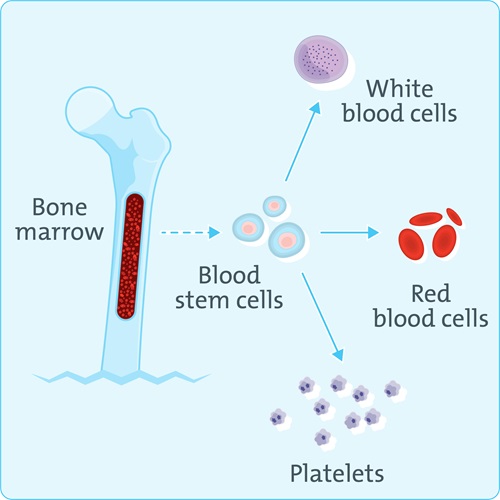In leukaemia, blood cells overgrow and turn into cancer leukaemia cells. The leukaemia cancer cells replace normal blood cells and make it hard for the bone marrow and organs to work properly.
Leukaemias are divided into four groups that explain what they do in the body. Leukaemia is either acute (aggressive and growing quickly) or chronic (growing more slowly over a longer time). Acute and chronic leukaemias are either lymphoid or myeloid, named for the type of stem cell they started from.
Acute leukaemias
Acute leukaemias happen when new stem cells (called blasts) multiply too much. Blast cells in the bone marrow are supposed to grow into blood cells. In acute leukaemias, there are too many blast cells and they form cancer instead
The cancer cells can spread from the bone marrow to blood, lymph nodes, liver, spleen and other organs.
It’s important acute leukaemias are treated quickly.
Genomic testing of acute leukaemia cancer cells can help us to pinpoint their type and find abnormalities. We can use this information to personalise treatment.
-
Acute myeloid leukaemia (AML)
Acute myeloid leukaemia is the most common acute leukaemia in adults in Australia. It most commonly affects people over the age of 60.
Symptoms of acute myeloid leukaemia
- fatigue
- skin paleness
- high heart rate
- fever higher than 38°C
- frequent infections
- abnormal bruising or bleeding
- nosebleeds
- petechiae (small dots on the body, caused by bleeding underneath)
- soreness inside the mouth
- weight loss with no explanation
- bone pain with no explanation.
-
Acute lymphoblastic leukaemia (ALL)
Acute lymphoblastic leukaemia is the most common leukaemia in children in Australia. It is much less common in adults but can affect any age group.
Read more: How is leukaemia diagnosed?
Chronic leukaemias
Like acute leukaemias, chronic leukaemias happen when blood cells multiply too much and form cancer cells. The blood cells causing chronic leukaemias are more mature, unlike the stem cells causing acute leukaemias.
Chronic leukaemias spread more slowly in comparison to acute leukaemias. Over time, the cancer cells interrupt the normal function of the blood, bone marrow and body.
Because it grows slowly, some people with chronic leukaemia won’t notice any symptoms. Some people are diagnosed when the cancer hasn’t spread and don’t need treatment yet, or ever. Others need treatment because the cancer is at a further stage.
To read about treatments for blood cancer, download our Epworth Patient Guide.
-
Chronic myeloid leukaemia (CML)
Chronic myeloid leukaemia (CML) occurs when leukaemia cancer cells multiply in the bone marrow and blood.
Genetic testing shows nearly all people with CML have an abnormal chromosome, which is a group of DNA. This chromosome, the Philadelphia chromosome, tells the body to make a protein (tyrosine kinase). Tyrosine kinase in the body can make blood cells develop abnormally, causing leukaemia.
About half of people with chronic myeloid leukaemia will notice symptoms. Most people are diagnosed after routine blood tests show unusual results.
Symptoms of chronic myeloid leukaemia
- fatigue and feeling unwell
- an enlarged spleen
- abdominal pain or indigestion
- eating less but still feeling full
- weight loss with no explanation
- pain to touch the sternum (breastbone in the middle of the chest)
- bruising easily
- sweating a lot more than usual.
-
Chronic lymphocytic leukaemia (CLL)
Chronic lymphocytic leukaemia (CLL) occurs when a type of white blood cell (B cell lymphocyte) multiplies in the wrong way and forms cancer. CLL is more common as we age.
Technology and genomic testing research in recent years has transformed CLL treatment in Australia.
Most people with chronic lymphocytic leukaemia won’t experience symptoms before diagnosis.
Symptoms of chronic lymphocytic leukaemia
- fatigue
- infection
- an enlarged spleen
- abdominal pain or indigestion
- eating less but still feeling full
- bleeding or bruising easily
- bone pain with no explanation
- strong reaction to insect bites
- sweating a lot more than usual
- swollen (larger) lymph nodes, usually in the neck and above the collarbone.
Referral for leukaemia
If you’re worried about symptoms, speak to your general practitioner (GP) first. They can assess symptoms, order tests and refer you to a blood cancer specialist (haematologist) if recommended.
Ask your GP for a referral to one of our leading Epworth haematologists in East Melbourne, Box Hill, Geelong and Richmond through the Epworth Centre for Immunotherapies and Snowdome Laboratories, a blood cancer centre of excellence.
Learn more about blood cancer care at Epworth and referrals for patients.

